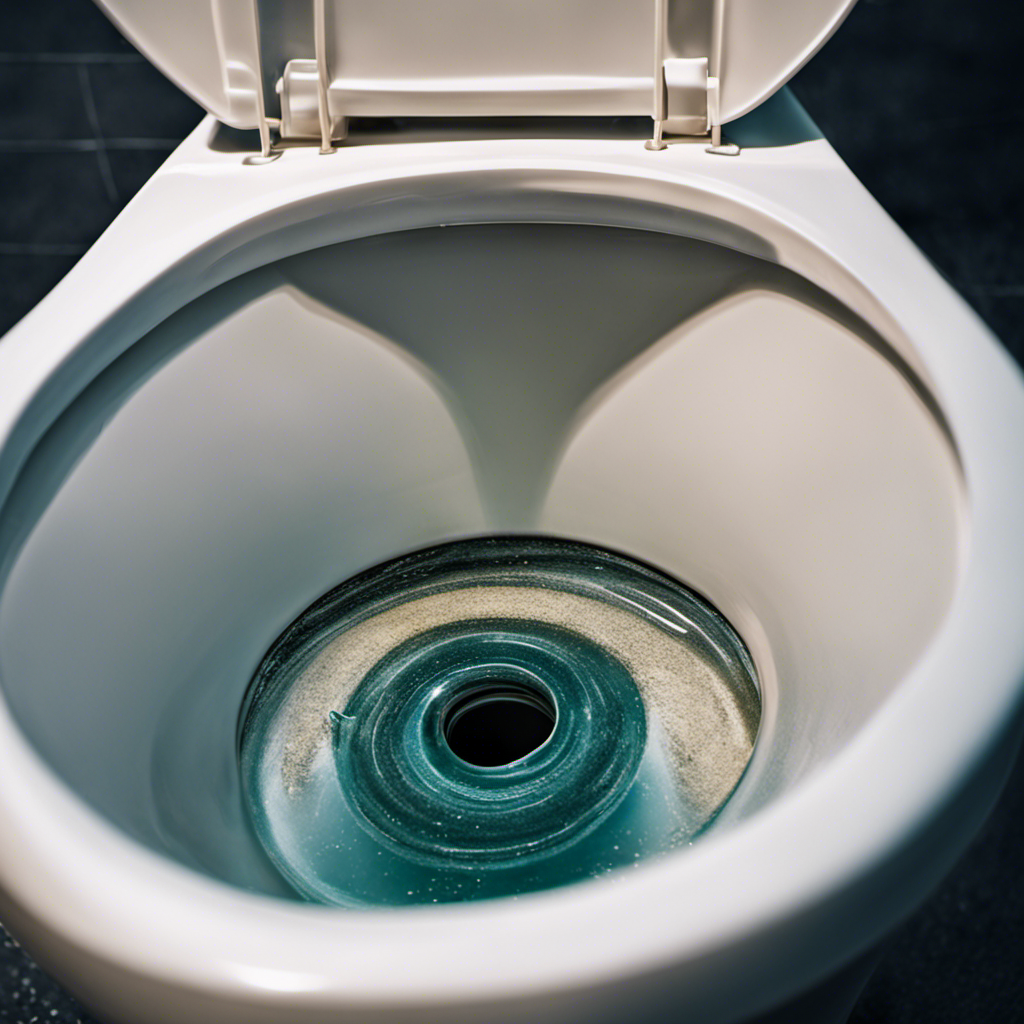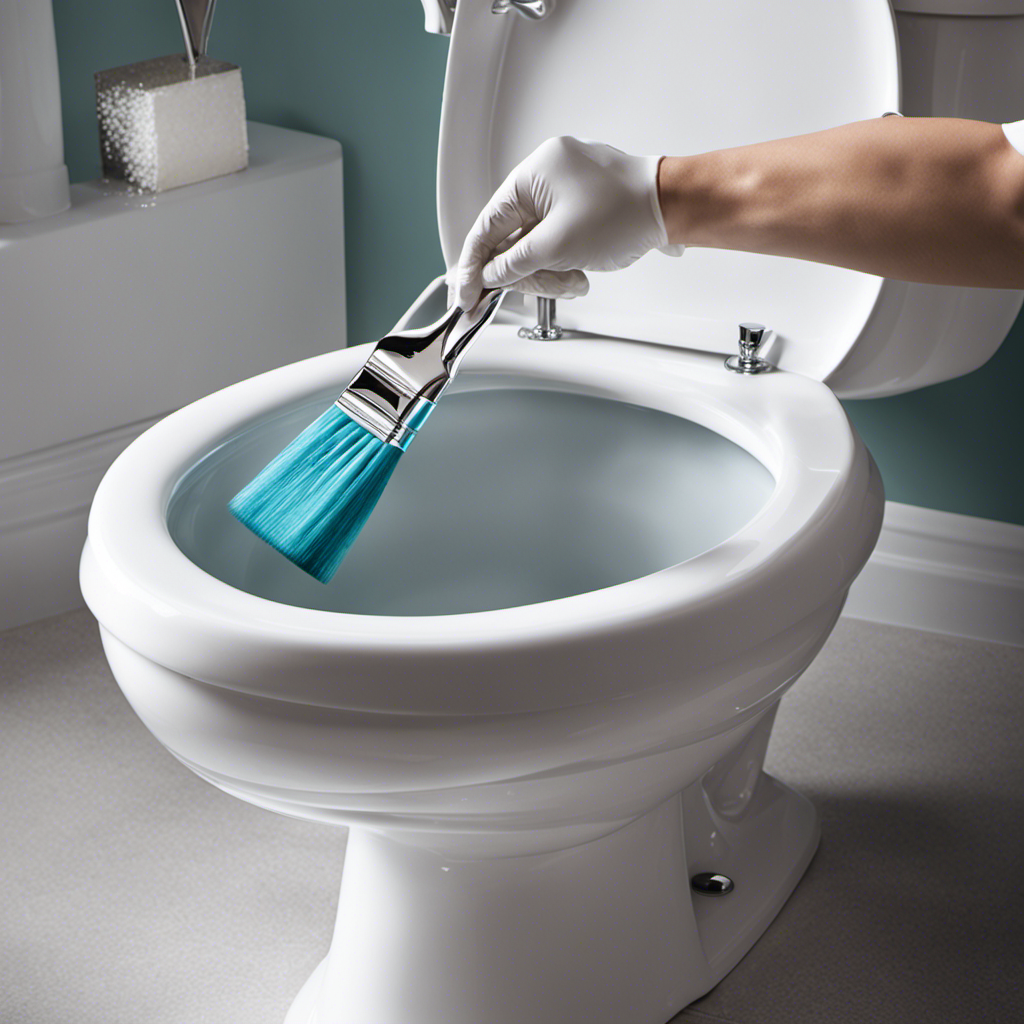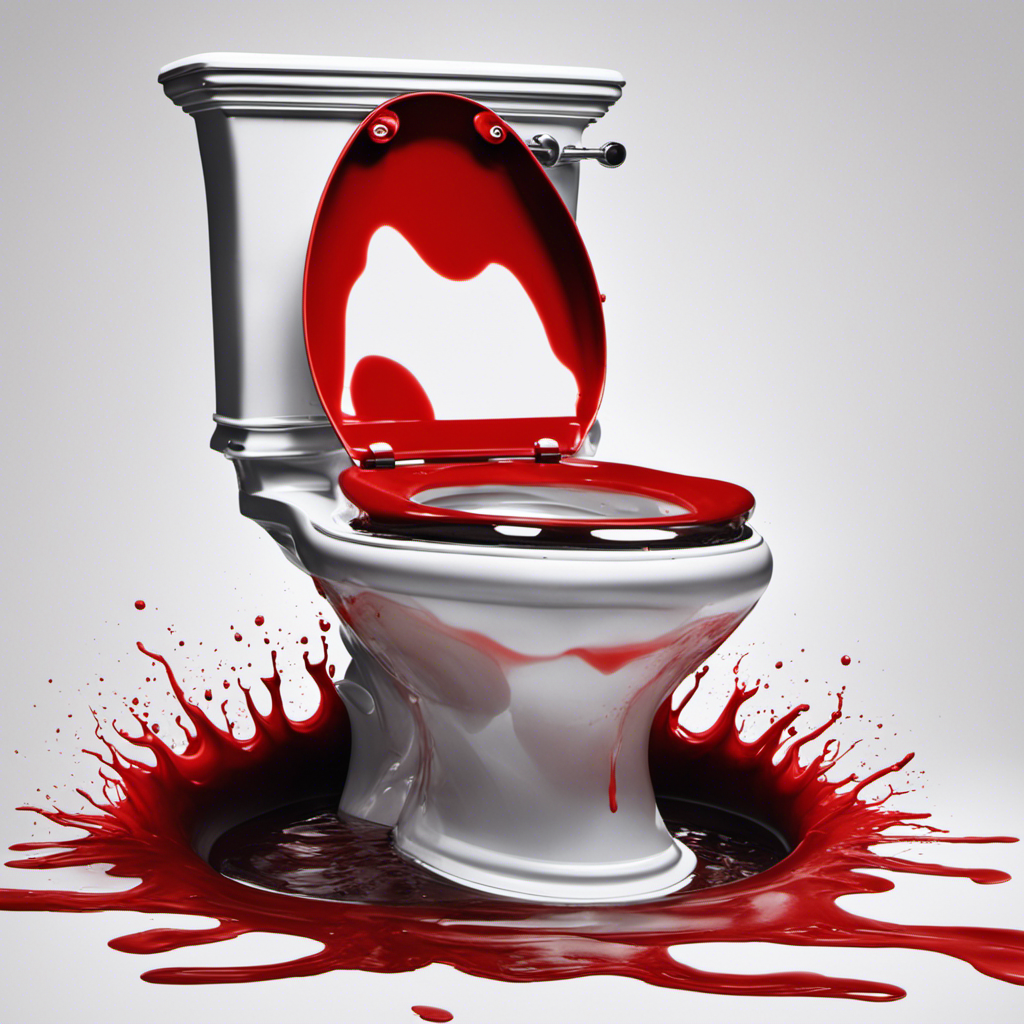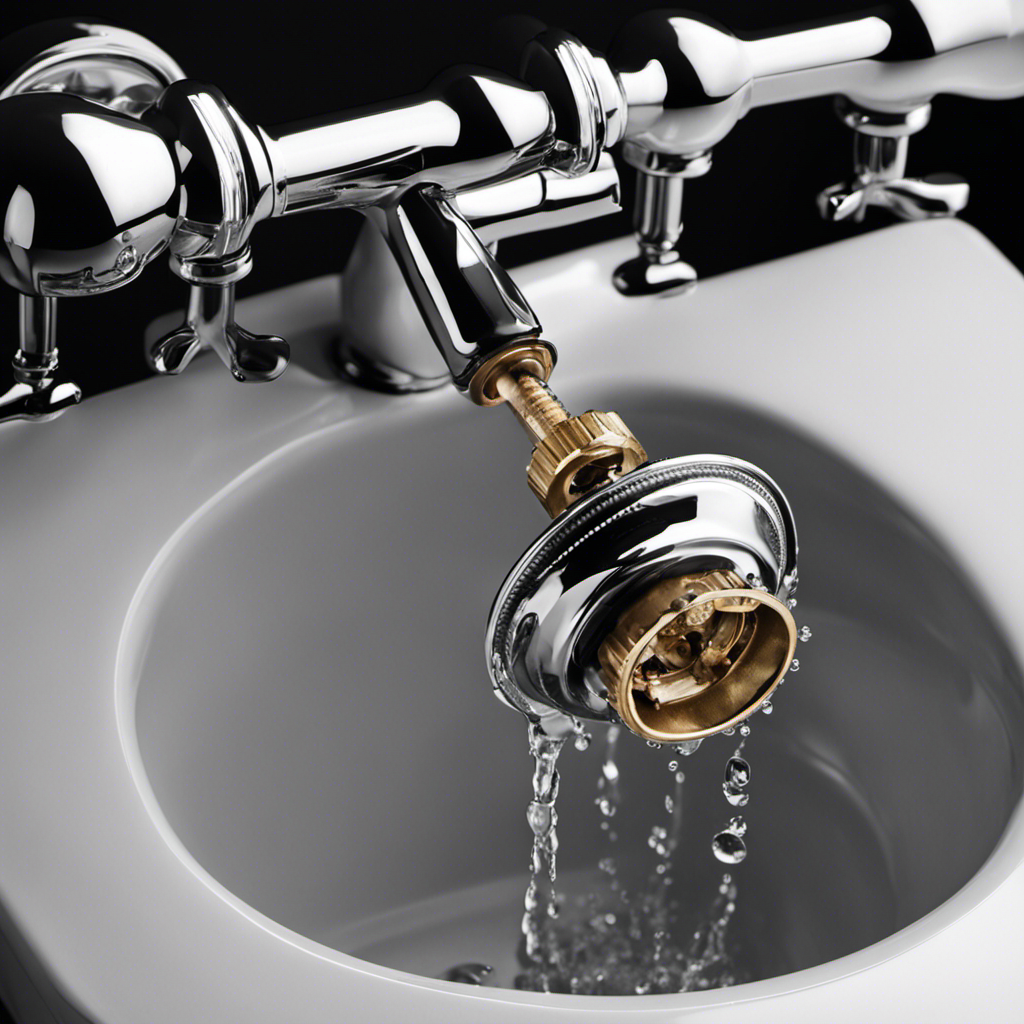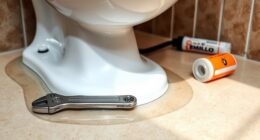Have you ever felt frustrated when your toilet just won’t flush properly? It can be incredibly annoying and inconvenient.
Well, I’ve got some good news for you! In this article, I’m going to dive into the common causes of incomplete flushing and provide you with the expert knowledge you need to fix the problem.
From blockages in the toilet drain to issues with the flapper valve, we’ll cover it all.
So, buckle up and get ready to say goodbye to those flushing woes!
Key Takeaways
- Common causes of incomplete flushing include clogged drains, faulty flappers, inadequate water pressure, and insufficient water in the tank.
- Blockages in the toilet drain can result from improper waste disposal, flushing non-flushable items, clogged sewer lines, debris buildup in the drain, or worn or damaged flushing mechanisms.
- Improper waste disposal can have environmental impacts such as solid waste blockages, water source contamination, and disruption of ecosystems.
- Sewer line maintenance and cleaning, regular inspection by a professional plumber, using toilet bowl cleaner, and regular maintenance and cleaning can help prevent clogs and ensure proper flushing.
Common Causes of Incomplete Flushing
Sometimes, you might experience incomplete flushing in your toilet due to common causes like a clogged drain or a faulty flapper. If you notice that your toilet tank is not filling up properly or that the water pressure seems weak, it can affect the flushing mechanism.
The toilet tank is responsible for holding the water that is released during a flush. If the tank doesn’t fill up fully, it won’t have enough water to create a strong flushing action. Similarly, if the water pressure in your plumbing system is low, it can result in a weak flush. Inadequate water pressure prevents the water from flowing forcefully enough to clear the waste effectively.
Now, let’s move on to the next section where we’ll discuss blockages in the toilet drain.
Blockages in the Toilet Drain
When it comes to blockages in the toilet drain, there are a few key points to consider.
First, improper waste disposal is a common culprit. People often flush items down the toilet that should be thrown in the trash, such as paper towels or feminine hygiene products.
Additionally, clogged sewer lines can also lead to blockages in the toilet drain. These lines can become obstructed with debris over time, causing water to back up and prevent proper flushing.
Lastly, a faulty flushing mechanism can contribute to incomplete flushing. If the handle or other components of the flushing system are worn or damaged, they may not be able to effectively remove waste from the toilet bowl.
Improper Waste Disposal
One common reason for a toilet not flushing properly is if you haven’t disposed of waste properly.
Improper waste management can have a significant environmental impact and can also cause issues with your toilet’s flushing mechanism.
When waste is not disposed of correctly, it can lead to blockages in the toilet drain, preventing proper flushing. Solid waste, such as sanitary products or excessive toilet paper, can easily get stuck in the pipes, causing clogs that restrict water flow.
Additionally, flushing items like diapers, wipes, or medications down the toilet can harm the environment by contaminating water sources and disrupting ecosystems.
It is crucial to follow proper waste disposal practices to ensure that your toilet flushes efficiently and to minimize your environmental impact.
Clogged Sewer Lines
If you flush items like diapers, wipes, or medications down the toilet, you can clog the sewer lines and cause serious plumbing problems. Clogged sewer lines are a common issue that can lead to toilets not flushing properly.
To prevent this, regular sewer line maintenance is crucial. This involves hiring a professional plumber to inspect and clean the sewer lines periodically. They have specialized tools and equipment to remove any debris or buildup that could potentially cause clogs.
Additionally, proper toilet bowl cleaning is essential for maintaining a clear and functional sewer system. Using a toilet bowl cleaner specifically designed for removing mineral deposits and build-up can help prevent clogs and ensure proper flushing.
Regular maintenance and cleaning are key to avoiding clogged sewer lines and keeping your toilet working efficiently.
Faulty Flushing Mechanism
To fix a faulty flushing mechanism, you’ll need to check the flapper and ensure it’s sealing properly. A common issue that can cause a toilet not to flush all the way is a worn-out or misaligned flapper.
The flapper is a rubber seal that lifts when you flush the toilet, allowing water to flow from the tank into the toilet bowl. If the flapper doesn’t seal tightly after flushing, water will leak from the tank into the bowl, reducing the water pressure and preventing a complete flush.
To check the flapper, simply lift the lid of the tank and observe the seal. If it appears worn or not seated correctly, it may need to be replaced. Maintaining a properly functioning flapper will ensure adequate water pressure for a complete flush.
Issues With the Flapper Valve
When it comes to toilet issues, there are a few key points to keep in mind:
-
Flapper valve malfunctions can occur when the valve becomes worn or damaged. This can lead to leaks and inadequate flushing. It is important to check the condition of the flapper valve and replace it if necessary.
-
Water level problems can affect the efficiency of the flush. If the water level is too low, it may not provide enough force to properly flush waste. If the water level is too high, it may cause overflow or inefficient flushing. Adjustments or repairs may be needed to ensure proper functioning.
-
Improper flapper adjustment can result in inconsistent flushing or continuous running. It is important to carefully adjust the flapper to achieve optimal performance. This may involve adjusting the chain length or the positioning of the flapper.
Overall, addressing these common toilet issues can help ensure that your toilet is functioning properly and efficiently.
Flapper Valve Malfunctions
The most common reason for a toilet not flushing all the way is when the flapper valve malfunctions. The flapper valve is a rubber stopper located at the bottom of the toilet tank. When you flush, the flapper valve lifts up to release the water into the bowl. If it doesn’t lift up properly or if it doesn’t seal tightly when it closes, water can leak out and the toilet won’t flush properly.
To maintain the flapper valve, regularly check for any signs of wear or damage, such as cracks or warping. If you notice any issues, replace the flapper valve.
Troubleshooting a toilet that won’t flush all the way starts with inspecting the flapper valve and ensuring it is functioning correctly.
Water Level Problems
Check if the water level in your toilet tank is set at the correct height. Having the right water level is crucial for a properly functioning flush. Here are some troubleshooting tips to help you fix any water level problems:
-
Adjust the fill valve: The fill valve controls the water level in the tank. If it’s set too low, the flush may be weak. Adjust the valve by turning the adjustment screw clockwise to raise the water level.
-
Check the float: The float is responsible for shutting off the water flow when the tank is full. If it’s damaged or misaligned, it can affect the water level. Ensure the float is in good condition and correctly positioned.
-
Inspect the flapper valve: A faulty flapper valve can cause water to leak from the tank, leading to a low water level. Make sure the flapper is sealing properly and replace it if necessary.
-
Clear any clogs: A clogged toilet can disrupt the water flow and prevent the tank from filling to the correct level. Use a plunger or a toilet auger to clear any blockages.
Improper Flapper Adjustment
Make sure that the flapper valve is adjusted properly to avoid any water leakage. The flapper valve is a crucial component in your toilet’s flushing mechanism, and if it is not adjusted correctly, it can lead to several issues, including incomplete flushing and water leakage. To ensure proper adjustment, you may need to replace the flapper or adjust the flapper chain.
Here is a table that outlines the steps for flapper replacement and flapper chain adjustment:
| Flapper Replacement | Flapper Chain Adjustment |
|---|---|
| 1. Turn off the water supply to the toilet. | 1. Check the length of the flapper chain. |
| 2. Flush the toilet to drain the tank. | 2. Adjust the chain length if necessary. |
| 3. Remove the old flapper by disconnecting it from the overflow tube. | 3. Ensure that there is some slack in the chain. |
| 4. Install the new flapper by attaching it to the overflow tube. | 4. Test the flush to ensure proper chain tension. |
| 5. Turn on the water supply and test the flush. | 5. Make adjustments as needed. |
Following these steps will help you properly adjust the flapper valve, ensuring a complete flush and preventing any water leakage.
Malfunctioning Fill Valve
I’ll need to replace the malfunctioning fill valve in order to fix the issue with my toilet not flushing all the way. The fill valve is responsible for refilling the toilet tank with water after each flush. If it is not functioning properly, it can lead to insufficient water flow, resulting in a weak flush or incomplete flush.
To troubleshoot fill valve issues, you can try the following:
- Check for any obstructions or debris in the fill valve
- Adjust the water level in the tank using the float adjustment screw
- Clean or replace the fill valve if it is worn out or damaged
- Ensure that the water supply line is fully open
By addressing these fill valve problems, you can restore the proper functioning of your toilet.
However, if the issue persists, it may be necessary to investigate problems with the flush handle or lever.
Problems With the Flush Handle or Lever
To fix any issues with your toilet not flushing properly, try adjusting the position of the flush handle or lever.
The flush handle is an important component of your toilet’s flushing mechanism. Sometimes, when the flush handle is not in the correct position, it can cause the toilet to not flush all the way.
If the flush handle is loose or feels weak when you push it down, it may need to be tightened or replaced. Additionally, if the flush lever is getting stuck or not returning to its original position after flushing, it can also cause flushing issues.
In this case, you can try lubricating the lever or adjusting its position. By troubleshooting the flush handle, you can often resolve common toilet flushing issues and ensure your toilet flushes properly.
Potential Clogs in the Sewer Line
Check if there are any potential clogs in your sewer line to determine the cause of your toilet flushing issues. A clogged sewer line can lead to a weak or incomplete flush, causing frustration and inconvenience.
Here are some potential solutions and troubleshooting tips to address this problem:
-
Use a plunger: Start by placing the plunger over the drain hole and applying firm pressure. This can help dislodge any blockage in the sewer line.
-
Snake the line: If the plunger doesn’t work, try using a plumbing snake to break up the clog and remove it from the sewer line.
-
Call a professional: If the clog persists or you’re hesitant to tackle the issue yourself, it’s best to call a professional plumber. They have the expertise and specialized tools to effectively clear the clog.
-
Prevent future clogs: Regularly maintain your sewer line by avoiding flushing non-flushable items and using drain covers to catch debris.
Conclusion
In conclusion, after investigating the common causes of incomplete flushing, it is clear that blockages in the toilet drain, issues with the flapper valve, malfunctioning fill valve, and problems with the flush handle or lever can all contribute to this frustrating problem.
However, it is also important to consider potential clogs in the sewer line as a possible cause.
By addressing these issues promptly, you can ensure a fully functioning toilet and avoid any further inconveniences.
So, next time your toilet won’t flush all the way, remember to check for these common culprits to maintain a smooth-flowing bathroom experience.

